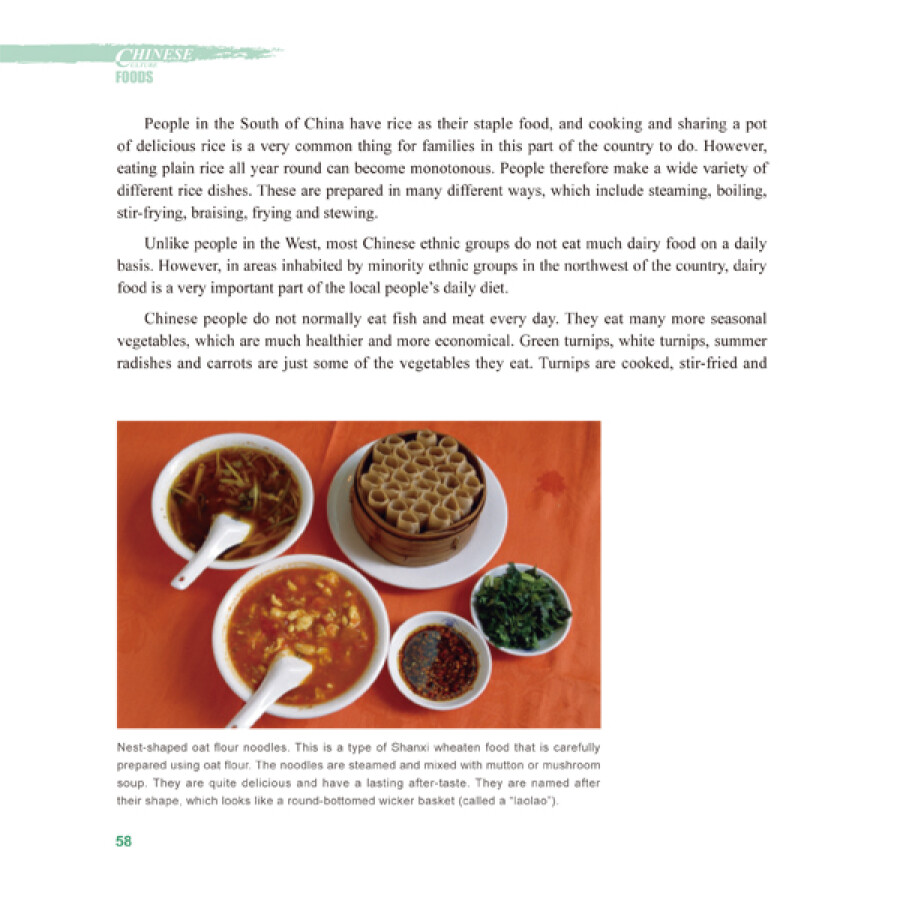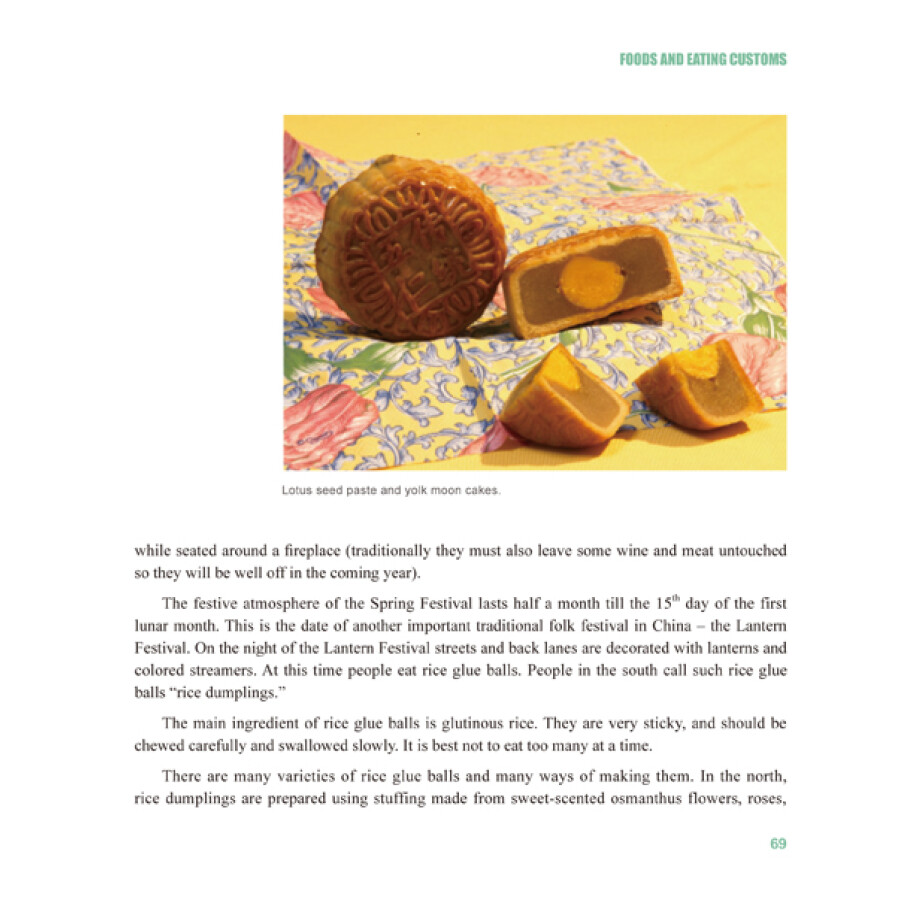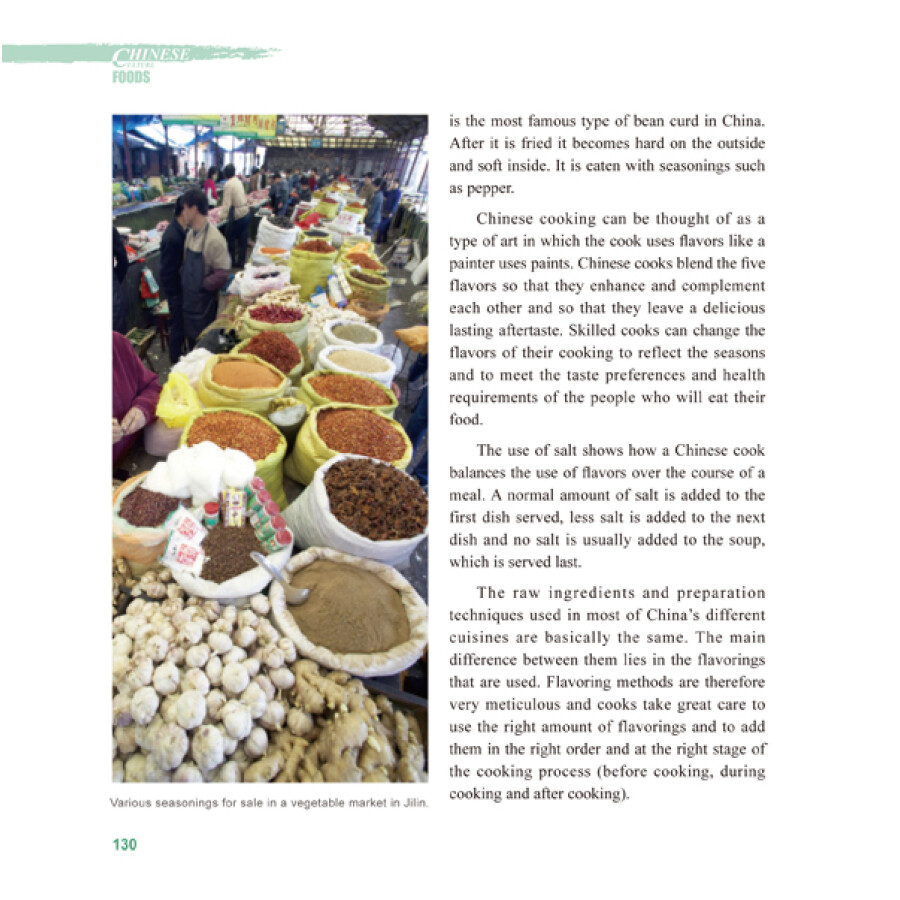Contents
Preface
The Origins oF Food
Traditional Foods
ForeigFoods
Eating Utensils and Etiquette
The Art of Chopsticks
Chinese Dinner Parties
Eating Etiquette
Food and Eating Customs
The Taste of Home Dishes
Eating During Festivals
The Eating Habits of Minority Ethnic Groups
Drinking Tea and Drinking Wine
Chinese People’s Fondness for Tea
The Joy of Drinking Wine
Food and Health
The Harmony of The Five Flavors
The Culinary Arts
Food for Health Preservation
Eating Taboos
Eating around China
Local Dishes with Distinctive Flavors
Snacks from around China
Restaurants iChina’s Various Regions
Postscript: My Meal ia US Cafeteria
Food for Health Preservation
Diet therapy is an important part of China’s eating culture. The Chinese have had a long tradition of taking foods as medicines and of taking medicines as foods. Indeed, Shen Nung, the agricultural god of Chinese legend, was not only meant to have taught people to cultivate crops, but was also known as the king of medicine who “tasted all herbs.” This myth reflects an important idea that lies at the heart of traditional Chinese medicine – “medicine and food have the same origin”. In other words, for the Chinese, eating food is very closely associated with the promotion of health and with the prevention and treatment of disease.
China’s medical classic The Yellow Emperor’s Internal Classic was the first Chinese book to highlight the importance of a varied diet to a person’s health. Today the importance of eating a nutritious and balanced diet is well known. Modern Chinese people therefore structure their daily diet so that it provides everything their bodies need to be strong and to resist disease. They also take food specifically as medicine.
Compared with medicines, foods are mild. However, despite this, many foods contain substances that can affect the wellbeing of the human bodies. For example, pears, bananas and kiwi fruit can all clear away heat (pears mainly clear away heat from the lungs, bananas mainly clear away heat from the intestines and kiwi fruit mainly clear away heat from the bladder). Foods with different tastes have different effects on the body. It is generally thought that “sourness enters the liver, piquancy enters the lungs, bitterness enters the heart, saltiness enters the kidneys and sweetness enters the spleen.” In other words, different flavors are absorbed by different internal organs. Foods that are too salty, sweet, sour or spicy are not good for the body. Too much salt harms the heart, spleen and kidneys and induces hypertension. Excessive sourness or piquancy can over stimulate the tissue of the gastric mucosa and cause ulcers. As a result, Chinese diet therapy emphasizes the harmony of the five flavors and a bland diet.
In the past, the diet of most Chinese people was predominantly made up of vegetables and grains and contained very little meat. This diet reflected the level of development of the country’s economy and agriculture at the time. However when this diet is analyzed from a health perspective it is found to be more healthy than diets rich in meat (like those eaten by many Western people).
Since ancient times Chinese people have believed that eating porridge will help them to live a long life. They therefore drink a bowl of thin porridge early in the morning every day. As the Chinese folk saying goes, “eating porridge is better than eating meat.” Porridge is particularly nutritious when it is stewed over a slow fire for a long period, as this concentrates the proteins, vitamins, inorganic salts and other nutrients its contains. Porridge is a source of water and can also enhance a person’s appetite. People who often eat fish and meat can get essential fluids by eating some five cereals porridge, vegetable porridge and edible wild herb porridge. This type of porridge also invigorates the kidneys. Eating it is an approach to “health preservation” that is particular to the Chinese people.
Many Chinese people who want to have a healthy diet choose to eat bland foods and a lot of porridge. They also eat vegetables regularly. This is a sensible choice as modern medicine has shown that foods made with raw materials such as vegetables, fungi and bean products are easily digested, very nutritious and, therefore, very healthy. The development of vegetable foods in China was closely related to the spread of Buddhism. When Buddhism spread to China, Buddhists had no strict food taboos. Later, in the Southern Dynasties (420-589), the pious Buddhist Emperor Wu of Liang (on the throne from 502 to 549) came to believe that eating meat was in violation of Buddhist doctrine, so he went to great lengths to advocate vegetable foods, prohibited monks from eating meat and drinking wine and harshly punished monks who disobeyed him. As a result, Buddhist temples banned wine and meat, monks began to eat vegetable foods all the year round, and “hermits”, who practiced Buddhism at home, began to behave in a similar manner. Many vegetable foods at the time were bland and unappetizing, but as vegetarianism spread so the quality and variety of vegetarian dishes improved. In particular, in order to meet Buddhists’ needs, many non-religious cooks began making and selling vegetarian dishes, and this greatly influenced the subsequent development of vegetarian food across China. In the Song Dynasty, because of the scholar-bureaucrats’ advocacy, vegetable foods became widely eaten. Modern Chinese people have realized that it is difficult to get enough nutrition from vegetables alone – for example, a vegetarian diet can be lacking in certain elements that the body needs, such as calcium. The majority of Chinese therefore follow diets that are balanced and which follow the advice of nutritionists and other health professionals.
The Chinese believe that it is important to pay attention to seasonal changes when deciding what to eat. For example, in the spring, when it gets warm, it is a good idea to eat some spicy vegetables as these can aerate the five internal organs. In the summer, when it is damp and hot, drinking foods such as mung bean soup, sweet-sour plum juice, lily soup and herbal tea can help prevent heatstroke and so protect a person’s health. In autumn, when it is dry, people should eat foods that can moisten the body and nourish the lungs. These include pears, persimmons, olives, radishes and white fungi. Chinese people particularly favor radishes, which are cheap and which also have notable health improvement qualities. Both spare-ribs braised with radishes and mutton stewed with radishes are used in diet therapy to preserve health. Chinese chestnuts, Chinese yams and field snails are also seasonal foods that are used to provide nourishment in the autumn. In winter it is particularly important to get enough “nourishment.” During this season, Chinese people therefore like eating fatty, high-calorie foods such as chicken, pork shanks, beef, mutton, longan, walnuts and sesames. Some people who are physically weak and afraid of the cold eat dog meat during the winter to make their bodies warmer.
Chinese diet therapy advocates particular foods for particular age groups. For example, middle-aged people are encouraged to eat both high-energy foods to preserve their health and anti-aging foods to slow down their bodies’ decline. Because old people’s metabolisms are slow, they are encouraged to eat less meat from four-legged animals such as cattle, sheep and pigs. They are also encouraged to eat more “two-legged” poultry, “one-legged” fungi and “no legged” fish.
More and more Chinese people are adopting the diet therapy approach to health protection. As the saying goes, “drug therapy is less effective than food nourishment, and diet therapy is more effective than drug treatment.” It is now widely known that common vegetables and fruits can prevent and cure diseases. In families that follow this approach it is known that if a family member catches a cold, he or she can get better if they drink hot soup (boiled with several slices of ginger, several sections of scallion stalk and brown sugar) and then sweat out their cold under a thick quilt.


